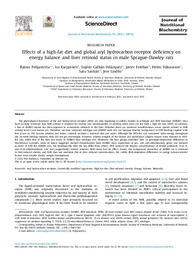Título :
Effects of a high-fat diet and global aryl hydrocarbon receptor deficiency on energy balance and liver retinoid status in male Sprague-Dawley rats |
Autor :
Pohjanvirta, Raimo 
Karppinen, Ira
Galbán-Velázquez, Suylen
Esteban Mozo, Javier
Håkansson, Helen
Sankari, Satu
Lindén, Jere  |
Editor :
Elsevier |
Departamento:
Departamentos de la UMH::Biología Aplicada |
Fecha de publicación:
2021-09 |
URI :
https://hdl.handle.net/11000/37577 |
Resumen :
The physiological functions of the aryl hydrocarbon receptor (AHR) are only beginning to unfold. Studies in wildtype and AHR knockout (AHRKO) mice
have recently disclosed that AHR activity is required for obesity and steatohepatitis to develop when mice are fed with a high-fat diet (HFD). In addition,
a line of AHRKO mouse has been reported to accumulate retinoids in the liver. Whether these are universal manifestations across species related to AHR
activity level is not known yet. Therefore, we here subjected wildtype and AHRKO male rats (on Sprague-Dawley background) to HFD feeding coupled with
free access to 10% sucrose solution and water; controls received a standard diet and water. Although the HFD-fed rats consumed more energy throughout
the 24-week feeding regimen, they did not get overweight. However, relative weights of the brown and epididymal adipose tissues were elevated in HFDfed rats, while that of the liver was lower in AHRKO than wildtype rats. Moreover, the four groups exhibited diet- or genotype-dependent differences in
biochemical variables, some of which suggested marked dissimilarities from AHRKO mice. Expression of pro- and anti-inflammatory genes was induced
in livers of HFD-fed AHRKO rats, but histologically they did not differ from others. HFD reduced the hepatic concentrations of retinyl palmitate, 9-cis-4-
oxo-13,14-dihydroretinoic acid and (suggestively) retinol, whereas AHR status had no effect. Hence, the background strain/line of AHRKO rat is resistant
to diet-induced obesity, and AHR does not modulate this or liver retinoid concentrations. Yet, subtle AHR-dependent differences in energy balance-related
factors exist despite similar weight development.
|
Palabras clave/Materias:
Aryl hydrocarbon receptor
Genetically modified organisms
High-fat diet
Diet-induced obesity
Energy balance
Retinoids |
Área de conocimiento :
CDU: Ciencias puras y naturales: Biología |
Tipo de documento :
info:eu-repo/semantics/article |
Derechos de acceso:
info:eu-repo/semantics/openAccess
Attribution-NonCommercial-NoDerivatives 4.0 Internacional |
DOI :
https://doi.org/10.1016/j.jnutbio.2021.108762 |
Publicado en:
The Journal of Nutritional Biochemistry, Volume 95, September 2021, 108762 |
Aparece en las colecciones:
Artículos - Biología Aplicada
|
 La licencia se describe como: Atribución-NonComercial-NoDerivada 4.0 Internacional.
La licencia se describe como: Atribución-NonComercial-NoDerivada 4.0 Internacional.
.png)
